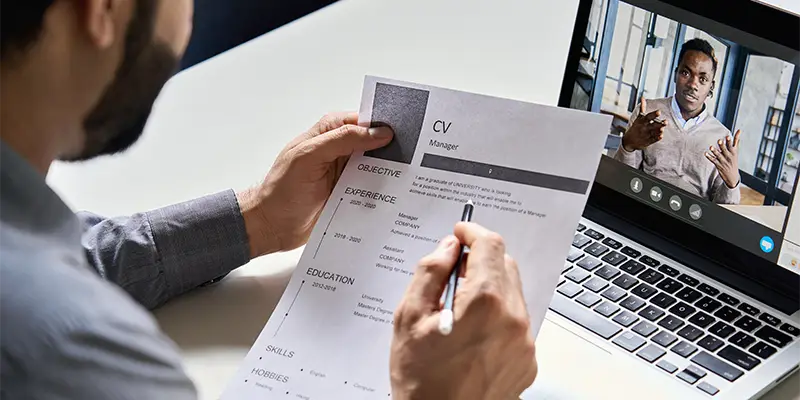
Get ready for your video interview: prep checklist, what to expect in one-way vs. live formats, platform tips, and mistake-proof strategies to stand out.
Video interviews have their advantages. Candidates don’t have to travel, hiring organizations have a wider net of applicants to choose from, and in the case of one-way video interviews, you can record (and rerecord) your interview answers. Then recruiters can review your interview at their convenience. Yet a survey found that 70% of applicants still prefer in-person interviews.
Candidates frequently cite concerns about video technology and internet connectivity, along with feeling uncomfortable on camera, as reasons they’re wary of video interviews. The good news is that proper preparation can help you overcome these concerns. The video interview tips below cover everything from video lighting to time limits and will help you nail your video interview and get the job you’ve been hoping for.
What is a Video Interview?
Unlike in-person job interviews, where all parties are in the same location at the same time, a video interview is conducted remotely using video technology. Not all video interviews are alike, however, and it’s important to understand the differences between a virtual interview versus an in-person interview so you can be fully prepared.
One-way Video Interview
Also known as asynchronous or async interviews, one-way video interviews are when applicants are not interviewed by a live person. Instead, they’re presented with a prerecorded or scripted series of questions via a special website link or software platform. They are then recorded as they give their answers.
Candidates are typically told how long they have for each response and can practice before they hit the record button. They may even be able to rerecord their responses. Organizations typically use async video interviews as a screening tool to narrow down a large number of applicants.
Live Video Interview
This type of video interview is closest to the old-school in-person interview. Candidates speak in real time with recruiters and hirers, but they’re not in the same physical space. Unlike with one-way video interviews, there will be real-time give-and-take with space for follow-up questions. Live video interviews have become standard for remote jobs. They might occur after or instead of async video interviews.
Case and Presentation Video Interviews
Case or problem-solving interviews require job candidates to explain how they would address a hypothetical situation presented by the interviewer. A presentation interview requires you to walk through, visually and verbally, how you would handle a situation, how you tackled a previous challenge, or examples from your portfolio. These formats are not unique to video interviews, but when done remotely, they do require you to be familiar with screen sharing, virtual slide presenting, and other technical skills. They may also be part of a one-way or live video interview.
Organizations typically reserve case video interviews for management consultants, marketers, and higher-level finance and tech candidates. Applicants for sales roles and other client-facing positions are most likely to be asked to give presentation videos, as are candidates for creative jobs, such as art director, where the hirer wants to be walked through the process behind a portfolio piece.
How to Prepare for a Video Interview?
Understanding the requirements and responsibilities of the role you’re going for is critical for a successful job interview, regardless of format. Beyond that, understanding the type of video interview you’re invited to can minimize surprises during the process and maximize your comfort levels. So, when possible, find out whether it will be an async or live video interview, roughly how much time to block out on your calendar, how many others will be participating, what (if anything) you need to present, and what software or platform you need. In the case of a one-way video interview, try to find out how much time you have to answer each prompt and if you’ll have the opportunity for retakes.
Equipped with that information, you can then prep yourself and your surroundings with the following video interview tips and checklists.
Setting Up Your Space
- Decide which room you’ll be sitting in during your video interview. Ideally, it’s a quiet space with a strong, reliable internet signal. If you share the room with others, lock the door or place a sign on it to remind others not to disturb you.
- Choose a calm, clutter-free background for your video interview that won’t distract from what you’re saying. We’ve all heard horror stories about interviewees sitting in front of questionable artwork or controversial books. Make sure your background looks professional and doesn’t have any visual distractions. Certain platforms, like Zoom, also have the option to choose a virtual background.
- Be sure to have proper lighting. Your primary light source, whether it’s a lamp or a window on a sunny day, should be in front of you. If it’s behind you, you’ll appear silhouetted. Webcams can be a great tool here, especially ones with a built-in ring light.
- Whenever possible, use a desktop or laptop computer for your video interview rather than a smartphone or a tablet. For one thing, even with a stand, a phone is less physically stable than a computer. For another, a computer’s larger screen enables you to use a split screen, with the interviewer in one window and your notes in the other.
- Position the camera to be eye level or just slightly above your eye line. This ensures your entire face will be in frame during your video interview, an important aspect of video interview etiquette.
- Have a glass of water at hand for the video interview. It’s better to take a sip when suffering from dry mouth or coughing than to mumble and hack your way through a question.
Conduct a Tech Check
- Confirm at least a day ahead of your video interview that you have the necessary software platforms installed and operational. Don’t assume that because you used the software last month or year, it’s still up-to-date on your device. Test it beforehand.
- Test your device’s camera, microphone, and speakers. Most video platforms offer practice features for this exact purpose.
- Check that your internet signal is strong enough. Run a quick speed test to ensure your connection can handle video without freezing or lagging.
- Consider setting up a hotspot on another device. Wi-Fi outages tend to occur during the worst possible moments! A backup hotspot can help you stay connected even after an outage.
- Be sure your devices are fully charged or plugged into an outlet, or both! You don’t want any of your devices to die during the interview.
- Prior to the video interview, close all unnecessary computer windows, tabs, and apps. Not only will this strengthen your internet access, but it will also prevent you from accidentally sharing something you shouldn’t or getting distracted during the interview.
- Silence any computer alerts as well as your cell phone. This will also minimize potential disruptions.
- Have a “script” ready in case of a tech snafu. Screens freeze, internet access drops, and other technical problems can arise, no matter how prepared you are. So, for live video interviews, rehearse a simple apology and explanation of the issue: “I’m so sorry, but the sound is cutting out when you speak,” for instance. Then offer an alternative, such as switching to a different device or asking to reschedule. Most importantly, stay calm. Think of the situation as a way to demonstrate how well you perform under pressure.
Presentation and Presence
- Dress as professionally for a video interview as you would for an in-person interview. Because the webcam will capture you only from the waist up, you might be tempted to wear sweatpants or shorts with your suit jacket or button-down shirt. Don’t. You never know if you might have to stand up to retrieve a file or adjust your camera. What’s more, dressing professionally from tip to toe helps you stay mentally in the zone.
- Keep jewelry to a minimum. It can be distracting on camera, and dangling jewelry can also be noisy.
- Sit up straight, with your feet on the floor. This ensures a professional posture.
- Log in to a live video interview at least five minutes before schedule. This gives you time to make sure everything is working properly, and it shows that you value promptness.
- When answering questions, make eye contact with the webcam, not with the interviewer’s image on your screen. This can take some practice, but the eye contact will make a strong impression.
- In a live video interview, nod and smile when appropriate to show that you’re listening and fully engaged, just as you would in an in-person interview.
- It’s fine to use hand gestures if that’s normal for you, so long as they’re not excessive or distracting. Again, this can take some practice!
- Practice answering questions out loud, and time yourself. Especially with one-way video interviews, you might otherwise find yourself speaking too rapidly to avoid running out of time.
- Prepare yourself for slight audio delays with live video interviews. To prevent accidentally talking over the interviewer, wait a second or two before responding to their question.
Structure Your Answers
The STAR — Situation, Task, Action, Result — method of structuring responses works in just about any interview situation. It’s especially helpful for one-way video interviews, when you typically have only 60-90 seconds to answer a question, and for instances when interviewers want an example of your behavior, such as: “Tell me about your proudest moment as a leader,” or “Describe a time you failed to meet a client’s expectations and how you responded.”
Begin by establishing the situation in one or two sentences. Next, explain the task: your responsibilities and the objective. From there, segue into describing your action, how you undertook and completed the task. The action portion of the response is where you can best demonstrate your ingenuity and initiative, so feel free to provide more detail here. Finally, wrap things up with the results. While providing metrics or other numbers is great, you can share other types of results too, such as process improvements you implemented or how management responded to your efforts.
Many find it helpful to type up key points and put them in a secondary window on their computer’s split screen for reference during the video interview. Be sure you come across as natural and not overly rehearsed, however, and avoid actually spelling out the steps (“The situation was…”; “My task was…”) in your responses.
What Candidates Say About Video Interviews
Hearing what others have experienced in video interviews can help you better understand and prepare for yours. Here are what candidates have said about important aspects of video interviews.
What Surprises Candidates During Their First Video Interview
Because so many of us have taken part in professional or personal video calls, live video interviews don’t present as many surprises as one-way video interviews. The timers and the lack of live response during async interviews do throw off many candidates, however. Some are also surprised by the limited number of retakes they’re allowed.
Common Video Interview Mistakes
Many candidates regret failing to give the computer platform, speakers, and camera a test run prior to their video interview. Even when all went smoothly, they were on edge, which came across in their answers and behavior. Going off on tangents while responding, speaking too quickly, gesturing too broadly, and visibly referring to notes are all other common pitfalls. Fortunately, practice can prevent most, if not all, of them!
Video Interview Platform Tips
The above suggestions apply whether your video interview is being conducted via Zoom, Microsoft Teams, or another platform. However, each platform has its own unique features you should be familiar with ahead of time.
Zoom Interview Tips
When you sign on for your Zoom interview, you’ll be asked for permission to use your device’s microphone and camera. Once you grant that permission, you can see how you’ll appear to others and be able to test the volume of your speakers. You’ll also be prompted to enter your name. If the interviewer is not yet on the call, you’ll probably be ushered into a virtual waiting room until the host is ready to admit you to the call.
Among Zoom’s handy features are the Mute button, which will prevent others from hearing noises on your end when they’re speaking, and the Share Screen function is important for case and presentation interviews. Another useful function is Chat, which enables participants to type messages to each other. Should your audio or microphone fail during the video interview, you could send a chat to the interviewer to let them know.
Microsoft Teams Interview Tips
Joining a Microsoft Teams meeting is similar to logging into a Zoom live video interview. You’ll be prompted to turn on your webcam and microphone, and you may need to wait in the virtual lobby until the interviewer has logged in as well. Also, like Zoom, Teams has a Mute button, in-meeting chat for sending and receiving typed messages, and a screen-sharing function. It also enables you to turn on live captions during your interview, should you be concerned about the quality of your speakers or the interviewer’s microphone.
AI Video Interviews: What to Expect
AI is changing just about every aspect of business, and job interviews are no exception. Many organizations use AI in conjunction with one-way video interviews to more quickly and objectively score candidates. Natural language processing (NLP) may analyze applicants’ words to gauge their understanding of the position and feelings about the organization. Facial and speech recognition evaluate tone of voice, eye contact, and facial expressions for engagement and confidence levels, among other elements. While some candidates worry about bias or fairness in AI-driven interviews, most organizations use these tools to create consistency. They aim to eliminate or reduce bias by analyzing all candidates on an identical set of questions and criteria.
Whether or not your video interview is AI-powered, preparation will look the same:
- Practice and time your responses, as you'll likely have just 60-90 seconds to answer each question.
- Don’t memorize scripts. Rehearse using frameworks such as STAR, but don’t come across as if you’re answering questions by rote.
- Maintain eye contact with your device’s camera, just as you would with a human interviewer. If you need to refer to notes, do so subtly.
- Don’t eliminate your natural vocal intonations, facial expressions, and body language. Keep them professional and genuine.
Frequently Asked Questions
What are typical video interview questions?
Video interview questions are usually similar to, if not the same as, in-person interview questions. You can expect questions like: “Tell me about yourself,” “Why are you interested in this position?”, “Why do you think you’re a good fit?”, and “Tell me about a recent project you’re proud of and why.”
How long should my answers be in a video interview?
In a one-way video interview, you’ll typically be given 60-90 seconds for each response. Practicing and timing your answers in advance will help you avoid speaking in a rush or being cut off mid-answer.
How long are video interviews?
It depends on the format. Recorded or async interviews typically last between 10 to 30 minutes. A video interview for a technical role may last up to an hour, and an interview with a panel could last as long as an hour and a half.
Can I use notes in a video interview?
Yes, you can use notes in a video interview, but you don’t want it to appear obvious that you’re doing so. Using a split screen, with your notes in one window and the interviewer in the other, can help you refer to your notes while maintaining as much eye contact with the camera as possible while you’re speaking.
What should I wear for a video interview?
Dress just as professionally for a video interview as you would for an in-person interview. Keep in mind, though, that busy patterns and lots of jewelry can be more distracting on camera than in person.
What if my internet drops during my live video interview?
First of all, remain professional. You wouldn’t be the first person this has happened to. Try to rejoin the call, then once you reconnect, apologize and proceed. If you can’t reconnect, try your backup hotspot device. Should that fail, reach out to the interviewer via email, Chat, or audio call as quickly as possible. Explain the situation and suggest switching to an audio call or rescheduling. Afterward, whether you reconnected or rescheduled, apologize once again in your thank-you email.
Next Step: Prepare for Pre-Employment Assessments
In addition to video interviews, many organizations have candidates take pre-employment assessments to gauge their motivation levels, personality traits, and cognitive abilities. The Wonderlic Candidate Hub offers practice tips and guidance to prepare you for the tests so you can land the job you’ve been working toward.
Weekly insights to hire smarter






